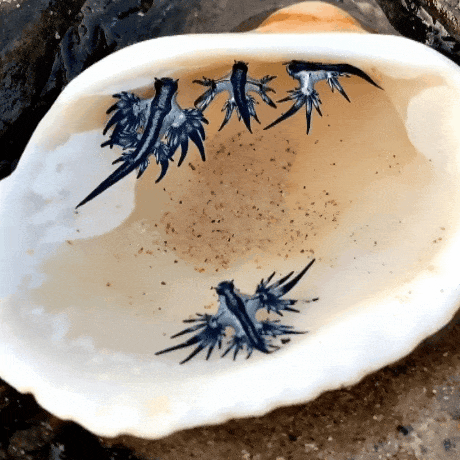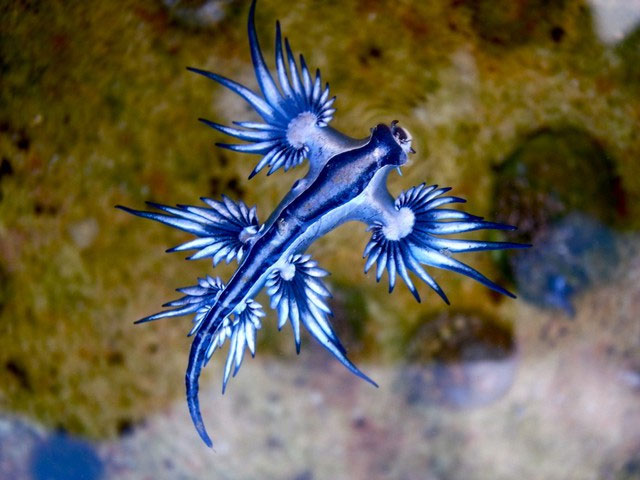Blue sea dragon: A sea slug that possesses beauty as if it came out of mythology but has deadly poison!
Glaucus atlanticus, also known as the blue sea dragon, angel slug or blue angel, is a small species of sea slug in the family Glaucidae. This species is found in temperate and tropical waters around the world.
The blue sea dragon (Glaucus atlanticus) is a type of mollusk called a sea cucumber. Despite its impressive appearance, in reality this animal is rarely more than three centimeters long. It can be found drifting on the surface of the Atlantic, Pacific, and Indian Oceans in temperate and tropical waters.

Glaucus atlanticus feeds on highly venomous siphonophores.
Unlike other sea cucumbers that feed on sponges and coral, Glaucus atlanticus feeds on highly venomous siphonophores . Through small tentacles located in the mouth, the blue sea dragon clings to its prey and can eat it. This slug is blue or blue-green in color with black and white stripes. Their bright colors help them camouflage in their environment and warn predators of toxins.
Blue sea dragons live on the surface of the ocean, using air bubbles in their abdomen and the surface tension of the water to float. The green color of this animal is not just for beauty. The sea god slug takes advantage of its color as it floats on the ocean surface. Its cyan side faces up to camouflage against the blue of the sea, while its silver side faces down to camouflage against the bright surface of the water.

The blue sea dragon has a soft, long and narrow body. Their legs are short and have pointed toes, which help them grip surfaces. This creature has a set of small but sharp teeth, used to eat its prey.
In addition to camouflage, green dragons also have quite malicious defense mechanisms. Although the slug itself is not venomous, it stores toxins produced by the organisms it feeds on, including venomous siphonophores and Portuguese man o' wars. . These toxins are concentratedly stored so when touched, green sea dragons can release toxic cells to create a "punch" that is even stronger than the original poison coming from their prey.
The mating of blue sea dragons is also very interesting. Because they are hermaphrodites, each animal will have both male and female reproductive organs. After mating, the blue sea dragon will lay a clutch of up to 16 eggs. They like to lay their eggs on floating scraps of food or something that floats so the young can float on their own when they hatch. The eggs will hatch within a few days.

Blue sea dragons are carnivores, preying mainly on hydras, siphonophores and other small creatures. They are slow swimmers, often spending most of their time floating on the water's surface. Blue sea dragons are hermaphrodites, which means they can get pregnant and lay eggs. They lay their eggs in a foam float that floats with the current.
The blue sea dragon's striking blue appearance makes some people want to keep them in their home aquarium. And in fact, if we raise this animal, we cannot find food for them at the pet store.

Glaucus atlanticus has tetrodotoxin (TTX) on its skin , a powerful neurotoxin that can be fatal to humans. Even after death, their venom remains and stepping on it or picking it up can result in a burning sting accompanied by symptoms like nausea, pain, vomiting, etc.
Researchers are recently finding these small animals in new locations. This may be due to warming oceans, combined with increased storm activity, causing them to drift further apart or onto different shores.
Researchers adjusted the green dragon's range more than 93 miles north into the Gulf of California after fishermen caught them during a 2015 fishery. In 2017, they were discovered in Taiwanese waters. Loan. In May 2020, they surprised beachgoers in South Padre Island, Texas, and then in Cape Town, South Africa that November.
Among gastropods, sea slugs such as Glaucus atlanticus are notorious for having few fossil records. This is because their soft, boneless and shellless bodies cannot fossilize well. On the other hand, the fossil record has preserved much of the history of shelled gastropods from the earliest Paleozoic times (541 to 252 million years ago). Among other classes, Gastropoda fossils appeared during the Cambrian period (541 to 485.4 million years ago).
Like most marine animals, the blue sea dragon is facing a number of global challenges to its survival. These include:
Cannibalism: This sea slug will not hesitate to eat other blue specimens when given the opportunity.
Climate change : Global warming and ocean acidification are becoming additional threats to their survival.
Human Danger : Worldwide use of the Internet has contributed to the "detrimental" proliferation of green sea dragons (e.g., overfishing for the aquarium trade).
Natural predators: Some studies suggest that loggerhead sea turtles may be common predators of Glaucus atlanticus. In fact, one particular study revealed that green sea dragons take up 42% of the food in their stomachs.
- The rare 'blue dragon' washed up on the Texas coast
- Admire the beautiful blue dragon on the seabed
- Lamia: Women love is forgotten in Greek mythology
- 7 small creatures but deadly
- Beautiful sea slug species in the ocean
- The deadly truth inside the brilliant appearance of the 'killer' snail
- Chinese people are crazy about the dragon river
- Animal world is blue
- Hubble has discovered a 'mysterious golden dragon' 4 billion light-years away, spanning 5 galaxies!
- Giant carnivorous slug invades Britain
- Unique 'sea slug species' of a single use
- The 'one-eyed giant' - the mythical figure turned out to be real
 Surprised: Fish that live in the dark ocean still see colors
Surprised: Fish that live in the dark ocean still see colors Japan suddenly caught the creature that caused the earthquake in the legend
Japan suddenly caught the creature that caused the earthquake in the legend A series of gray whale carcasses washed ashore on California's coast
A series of gray whale carcasses washed ashore on California's coast Compare the size of shark species in the world
Compare the size of shark species in the world